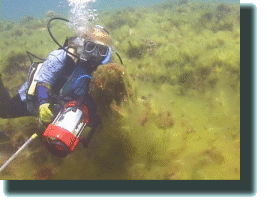
| Last week we reported another bloom of Cladophora sericea 41K JPEG |
Last week we reported another bloom of Cladophora sericea, our third in as many summers.
This week we experienced a south swell that kept us out of the water for a day. By the time we were able to return to our diving, the swell had made conditions worse. The waves had ripped up parts of Cladophora plants, then shredded the bits into the water column and turned our dive site into "pea soup."
The waves turned our dive site into "pea soup" 20K JPEG | 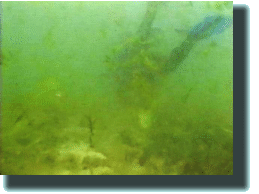
|
In deeper water, great quantities of Cladophora remain anchored to extensive beds of Halimeda, but this isn't the only plant blooming this summer.
Ever since we began diving here--as early as 1989--we noticed (and sometimes complained about) a "brown fuzz."
It is called Lyngbya majuscula.
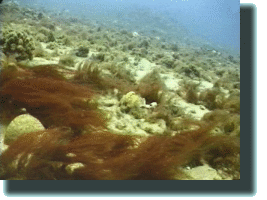
| The "brown fuzz" called Lyngbya majuscula 41K JPEG |
This brown fuzz is actually hair-like and can look like the hair-fuzz on the top of a baby's head; however, it can also grow to several centimeters long, either as an individual plant or as part of a community algal mat.
It can also grow to several centimeters long, either as an individual plant or as part of a community algal mat 41K JPEG | 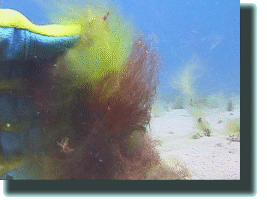
|
Over the winter we found an intriguing reference to Lyngbya majuscula: an abstract from Osborne et al, Human Toxicology and Epidemiology of the Marine Blue-Green Alga Lyngbya majuscula.
They write:
"Lyngbya majuscula is a filamentous blue-green alga with worldwide distribution throughout tropical and subtropical regions... Of the over forty unique biologically active chemicals isolated from this species, three toxins, debromoaplysiatoxin, aplysiatoxin and lyngbyatoxin A have been found to be the major cause of dermatitis. These three toxins are all tumor promoters, binding to phorbol esters receptors leading to the activation of protein kinase C."
Tumor promoting toxins are of great interest to us. Plants blooming in great profusion that might harbour such toxins demand close attention on our part.
This summer we're determined to monitor the abundance and distribution of Lyngbya carefully.
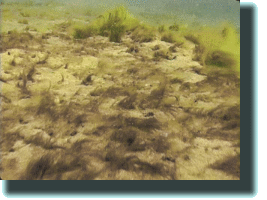
| We're determined to monitor the abundance and distribution of Lyngbya 45K JPEG |
We fully expect another "snail rain", likely by mid-August. We've noticed that a bloom of Lyngbya majuscula is followed by an explosion in the numbers of the sea slug Stylocheilus longicauda. This sea hare feeds on Lyngbya. Do they contain toxins too?
These questions and others continue to focus our attention on the algae growing at our dive site... but what about the turtles?
Completely absent last summer, our old friend Nui was sighted resting contentedly at North House this week. He let us get very close and we could see regression is holding. Good news for a friend we've known since 1990.
Our old friend Nui was sighted resting contentedly at North House 61K JPEG | 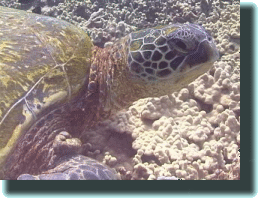
|
We've mentioned our interest in algae. [Ed. note: Boy, have we mentioned our interest in algae.] Another focus for this summer is documenting turtle eyes--particularly eyes that we know have had tumors in them but have regressed. We hope to build an image bank of turtle eyes showing various stages of fibropapilloma (FP) and then compare those to images of normal turtle eyes.
This kind of photography is the most difficult we've ever tried. We won't even use the word "challenging." It is clearly difficult.
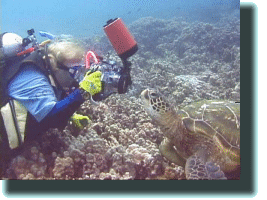
| This kind of photography is the most difficult we've ever tried 52K JPEG |
Many turtles will tolerate a close approach, but macro photography of just an eye requires a large housed camera and flash to be just inches away from a turtle.
Humans are uncomfortable with such intrusion and turtles are no different. Still, the results are worth it. Here is an example of Uwapo's left eye, which had a tumor in it in 1997.
Uwapo's left eye, which had a tumor in it in 1997 48K JPEG | 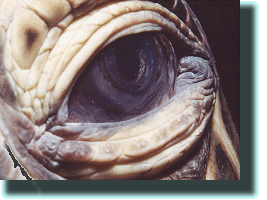
|
Uwapo is a regression case. The tumor is almost gone, but Uwapo's eye still bears evidence of its bout with FP.
More of the same. Document. Document. Document.
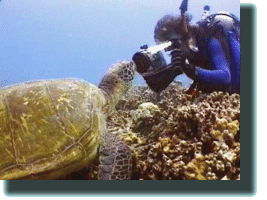
| Document. Document. Document. 47K JPEG |
 Who's Who Underwater at Honokowai
Who's Who Underwater at Honokowai